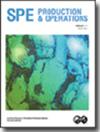基于深度学习的有杆抽油井工况诊断模型
IF 1.3
4区 工程技术
Q2 ENGINEERING, PETROLEUM
引用次数: 10
摘要
及时、准确地监测有杆抽油井的工作状态对石油生产具有重要意义。随着智能油田的发展,越来越多的传感器安装在油井上,监测到的数据不断传输到数据中心,形成大数据。本课题旨在利用油井生产过程中采集的大数据,结合深度学习技术,建立新一代有杆抽油井工况监测智能诊断模型。收集并预处理了超过5×106的油井监测记录,涵盖了一个油田区块约1年的300多口井的信息。为了反映井况的动态变化,提出了叠加式测功卡,并对每条数据记录进行了绘制。将工况划分为30种类型,并创建相应的数据集。提出了一种基于深度学习框架之一卷积神经网络(CNN)的智能诊断模型。通过卷积和池化操作,CNN可以在不需要人工和先验知识的情况下隐式提取图像的特征。这使得CNN非常适合于对叠加式测功卡的识别。设计了工况诊断CNN模型的体系结构。CNN模型由14层组成,其中包括6个卷积层、3个池化层和3个全连接层。神经元总数超过1.7×106。利用叠加测功卡数据集对CNN模型进行训练和验证。对模型的精度和效率进行了评价。经过10次训练后,CNN模型的训练和验证准确率均大于99%。一个epoch的平均训练耗时为8909.5秒,诊断一个样本的平均时间为1.3毫秒。基于训练好的CNN模型,开发了有杆抽油井工况监测软件。该软件可运行7 × 24小时,对井的工作状况进行诊断,并向用户发出警告。它还有一个反馈学习工作流来定期更新CNN模型以提高其性能。现场运行表明,CNN模型的实际准确率大于90%。本文章由计算机程序翻译,如有差异,请以英文原文为准。
A Working Condition Diagnosis Model of Sucker Rod Pumping Wells Based on Deep Learning
Monitoring the working conditions of sucker rod pumping wells in a timely and accurate manner is important for oil production. With the development of smart oil fields, more and more sensors are installed on the well, and the monitored data are continuously transmitted to the data center to form big data. In this work, we aim to utilize the big data collected during oil well production and a deep learning technique to build a new generation of intelligent diagnosis model to monitor working condition of sucker rod pumping wells. More than 5×106 of well monitoring records, which covers information from about 1 year for more than 300 wells in an oilfield block, are collected and preprocessed. To show the dynamic changes of the working conditions for the wells, the overlay dynamometer card is proposed and plotted for each data record. The working conditions are divided into 30 types, and the corresponding data set is created. An intelligent diagnosis model using the convolutional neural network (CNN), one of the deep learning frameworks, is proposed. By the convolution and pooling operation, the CNN can extract features of an image implicitly without human effort and prior knowledge. That makes a CNN very suitable for the recognition of the overlay dynamometer cards. The architecture for a working condition diagnosis CNN model is designed. The CNN model consists of 14 layers with six convolutional layers, three pooling layers, and three fully connected layers. The total number of neurons is more than 1.7×106. The overlay dynamometer card data set is used to train and validate the CNN model. The accuracy and efficiency of the model are evaluated. Both the training and validation accuracies of the CNN model are greater than 99% after 10 training epochs. The average training elapsed time for an epoch is 8909.5 seconds, and the average time to diagnosis a sample is 1.3 milliseconds. Based on the trained CNN model, a working condition monitoring software for a sucker rod pumping well is developed. The software runs 7 × 24 hours to diagnosis the working conditions of wells and post a warning to users. It also has a feedback learning workflow to update the CNN model regularly to improve its performance. The on-site run shows that the actual accuracy of the CNN model is greater than 90%.
求助全文
通过发布文献求助,成功后即可免费获取论文全文。
去求助
来源期刊

Spe Production & Operations
工程技术-工程:石油
CiteScore
3.70
自引率
8.30%
发文量
54
审稿时长
3 months
期刊介绍:
SPE Production & Operations includes papers on production operations, artificial lift, downhole equipment, formation damage control, multiphase flow, workovers, stimulation, facility design and operations, water treatment, project management, construction methods and equipment, and related PFC systems and emerging technologies.
 求助内容:
求助内容: 应助结果提醒方式:
应助结果提醒方式:


